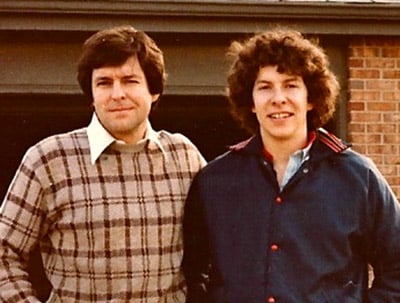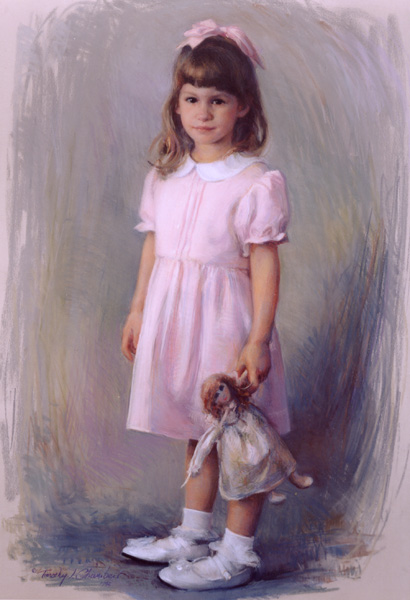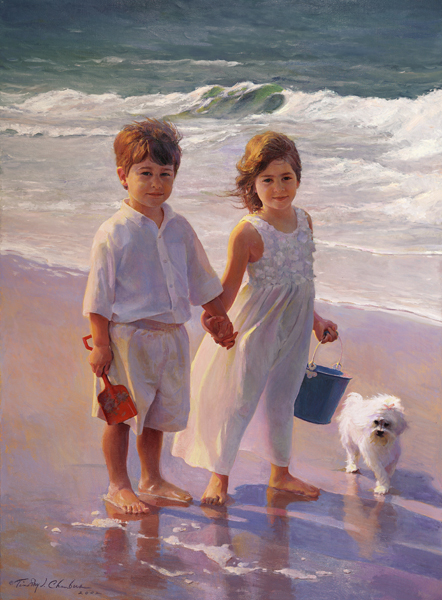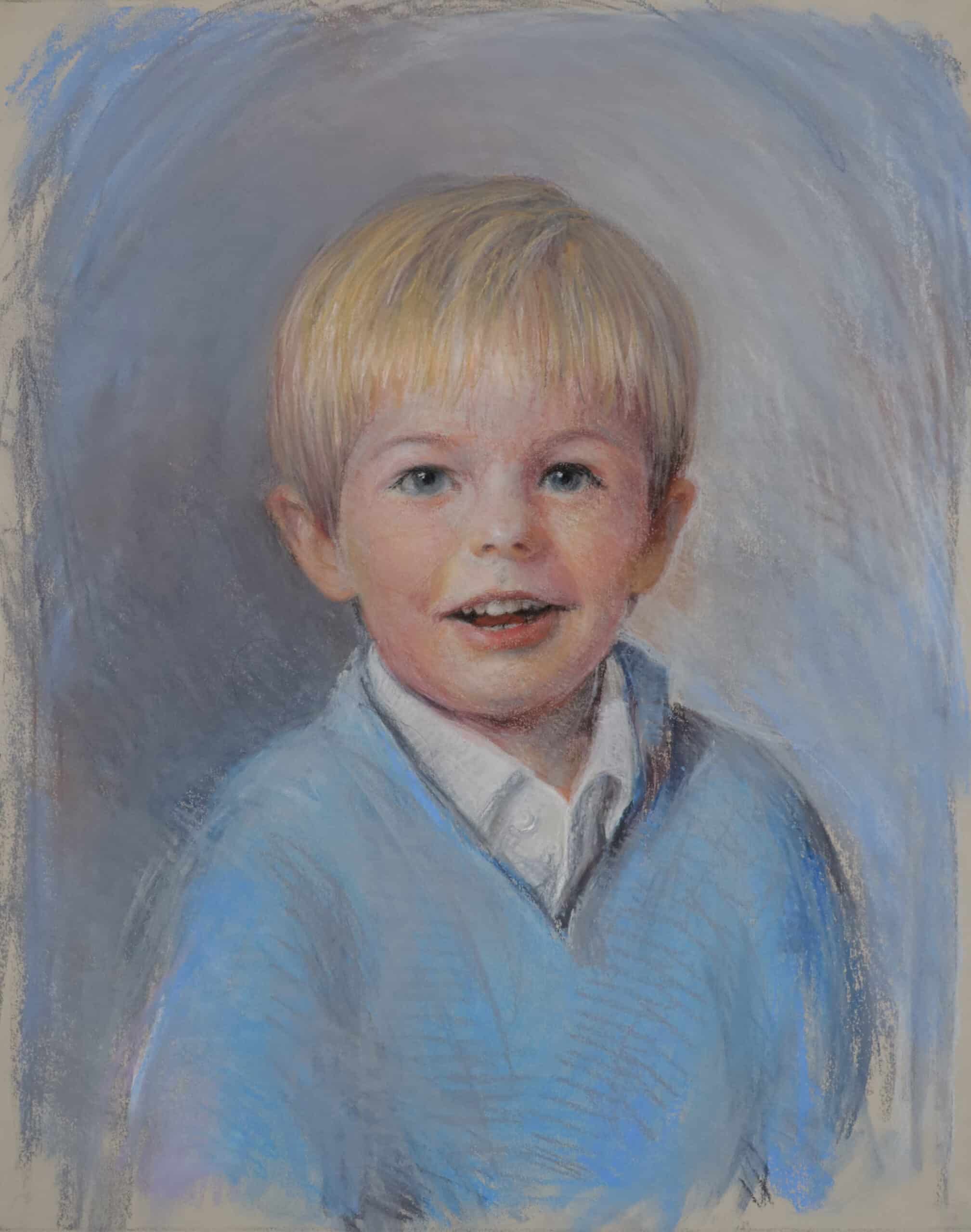17 DEGREES: TIM’S STORY
The unexpected series of events that led him to become a legally blind and deaf Master Painter
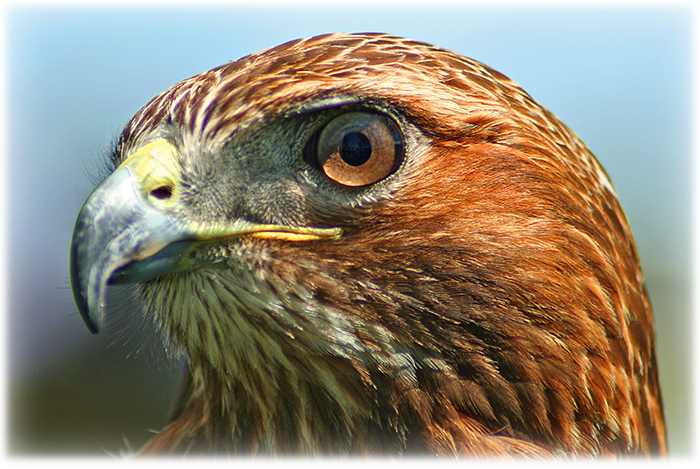
Did you know that a hawk’s range of vision spans approximately 290 degrees?
Talk about seeing things. No wonder a field mouse has no chance when in the hawk’s sightline. A hawk sees a whopping 60% more than you (humans have a visual field of 180°)! Dogs and cats have 240 degrees, about 40% more range than us two-leggers.
 Among people, artists are blessed with better vision, musicians with better hearing…. right? Not really, and sometimes far from it. Beethoven was deaf, Monet had cataracts. And I am also exempt from the great-vision-artists’-club, as my visual range is a tad less than yours by about 160 degrees, coming in at 17 degrees- less than 10% of yours. In fact, I am considered legally blind since I fall below the government’s minimum threshold of 20 degrees.
Among people, artists are blessed with better vision, musicians with better hearing…. right? Not really, and sometimes far from it. Beethoven was deaf, Monet had cataracts. And I am also exempt from the great-vision-artists’-club, as my visual range is a tad less than yours by about 160 degrees, coming in at 17 degrees- less than 10% of yours. In fact, I am considered legally blind since I fall below the government’s minimum threshold of 20 degrees.
The funny thing? I earn my livelihood as a professional portrait artist, which my dad calls the “king of art genres” due to the difficulty of truly capturing a person. God surely has a sense of humor. A guy with less than 10% of normal vision earning his living doing something as precise and challenging as painting portraits. Crazy.
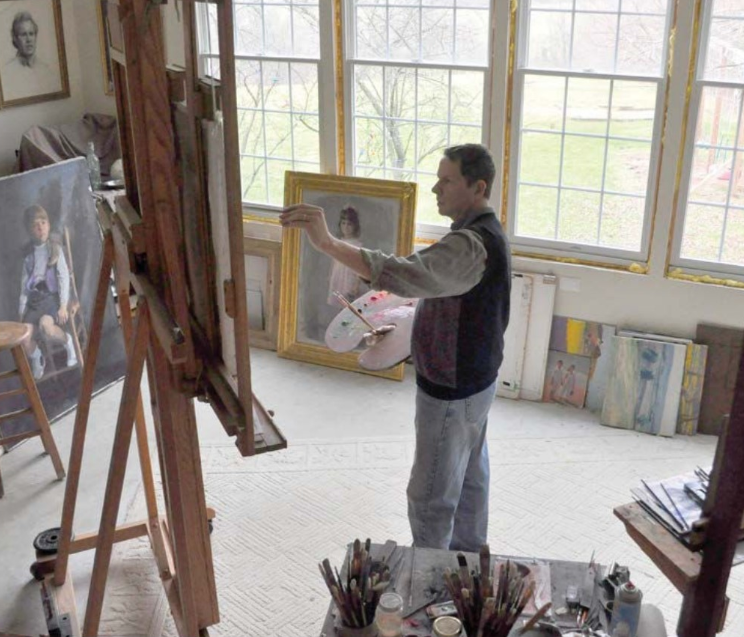 I am Tim Chambers, professional artist and founder of Iguana Art Academy. I am a legally deaf and blind artist. This is my story- my journey from aspiring young artist to being told I had a disease that would render me deaf and blind, and the journey that followed.
I am Tim Chambers, professional artist and founder of Iguana Art Academy. I am a legally deaf and blind artist. This is my story- my journey from aspiring young artist to being told I had a disease that would render me deaf and blind, and the journey that followed.
I’ve been a full-time professional artist for thirty years. I have been around art my whole life, as my dad, William Chambers, is also a professional artist (williamchambers.com). I made my career choice by the time I was three, coloring in the shadow of my dad’s easel. I love art. I can’t imagine being anything else. It’s how I process thoughts, take in everything in life. I think visually. I speak in word pictures (my hands are never in my pockets).
Yet, with less than 10% of normal vision, it’s common for people to ask how I can paint when I see so little. Actually, I probably see more than most people. Although I lack peripheral vision, I can see what I am looking at, and for an artist, that’s a great place to start.
Being a painter is more than merely recording what we see. Seeing also involves the heart and mind, and then comes the execution of applying that vision to canvas. A camera records objectively, without passion, without a past, without heart. “Anything under the sun is beautiful if you have the vision; it is the seeing of the thing that makes it so,” taught American painter Charles Hawthorne. I agree.
I was diagnosed with Usher Syndrome right when my career was ready to go into orbit. It terrified me. It’s been a journey fraught with fears, understanding, and growth. As time passes, the miracle of painting with diminishing vision grows, as does the curiosity. People want to know my story- how I can paint at such a high level, and press on with enthusiasm in life, in spite of having such little vision. Especially after watching me bump into a stranger, have a face to face meeting with a pole, trip over my dog (poor girl).
I do, because today, I can. Moments, especially challenging ones, are an opportunity to pick up your brush and make something beautiful out of a mess. Here’s my story…
Early Training
Growing up, I always knew I was going to be an artist. When I wasn’t playing outside, I drew. And drew. And drew. If I could turn a school project into an art project, I did. My high school had an incredible art department, and my teacher, Vince Sebastian, nurtured me endlessly. My dad suggested I consider other careers (doctor, teacher) instead of the ever-treacherous path of trying to earn a living in the arts, but seeing my resolve to be a painter, he gave me his blessing to pursue the best training. He knew (and warned me) that I needed to be able to compete with him if I was going to succeed, and there was much to learn.
College was an adventure. Dad had set a high standard for an artist. I earned a few scholarships, selected a big university of 30,000 students. Abstract art was the norm. Even the best colleges were about conveying emotions and personal thoughts rather than developing the skill to express such. It was like telling someone to write without knowing the alphabet or grammar. I was taught that the only absolute was that there were no absolutes (funny, really), and certainly no clear definitions of what constituted beauty. Bottom line: I wasn’t getting the training I needed to be a skilled painter. Imagine a musician graduating college unable to play anything but dissonance. Skill is necessary to success. I was frustrated, not learning what I needed.
Always one to find a solution, my dad discovered a school down in Nashville, Tennessee that taught the traditional tools of illustration- draftsmanship, anatomy, composition, lettering, and more. Come fall of 1982, I would be transferring from a school of 30,000 students to one of 90. Yes, ninety. The Harris School of Art in Franklin, Tennessee had less than 1 percent of the students from my college. Did someone say small? Suddenly I knew everyone on campus!
I was enjoying my first semester at Harris, learning southern-speak (“Coke” was generic for all soft drinks, not just one; one-syllable words became two… “Wow- what a beautiful dray-ess, y’all!“) when my dad called and said he found a school in the heritage of the Boston School (amazing painters like Paxton, Tarbell, Benson, Gammell, Lack) that I might be interested in up in balmy Minneapolis, Minnesota. It was Richard Lack’s atelier (French for studio), and he accepted a maximum of twelve apprentices. 30,000 > 90 > 12. Smaller…a clue of things to come. I said a sad goodbye to my friends at Harris and trekked up to Minneapolis after Christmas. It. Was. Cold.
Studying at Atelier Lack was a great experience, as I learned centuries-old practices of drawing and painting. I enjoyed the privilege of studying under Mr. Lack, an amazing painter with a wry wit. Stephen Gjertson was my other instructor there. Both were patient, kind, serious teachers, generous and enthusiastic to instruct us younger painters. I learned the art of patient and astute observation at Atelier Lack. I also made some good friends, including one who matched my bizarre sense of humor, and remains a best friend decades later, Carl Samson. Carl is an outright incredible artist. Carl and I transformed Atelier Lack from a deathly serious school to one alive with humor and vitality.
While studying at Lack’s, my dad found out about an American master teaching in Provincetown, Massachusetts. The Cape School of Art was started a hundred years earlier by American master Charles Hawthorne, a student of another master, William Merritt Chase. Artists who studied here include Emile Gruppe, Norman Rockwell, Max Bohm and Richard Miller. The current teacher carrying on the tradition was 84-year-old American Impressionist Henry Hensche, a student of Hawthorne. My best friend Kevin and I drove out to the Cape in my ’74 Firebird (a beauty with a great stereo…). Studying at Ptown would change how I see the world, striking a chord in my heart that resonates stronger than ever today, thirty years later.
Sand Pit Epiphany
Prior to meeting Henry Hensche, my focus had been on accurate drawing. I had honed my drawing skills, developing my sense of values (shading) and draftsmanship, trusting my dad’s counsel (“Color will come; first excel at drawing, Tim.”). In fact, I was so focused on that goal that I had not given any attention to studying the great painters of the past. In one quite humorous exchange, Henry Hensche at once revealed my dearth of knowledge and opened up a golden opportunity. Here’s the gist of that conversation:
SCENE: Kevin and I painting in what was called the “Sand Pit” behind the Cape School studios, a small yard consisting of wood tables, weathered gray by decades of the salty coastal elements. We were painting colored blocks- the standard training tool of the Cape School. I was struggling with capturing the colors of a yellow block. When I mixed black and yellow to paint the shady side of the block, my yellow turned green. Ugh. I was clueless. Along comes Henry to check in on how I am doing.
HENRY HENSCHE: How is it going? What’s your name? Where are you from?
TIM: Hi, Mr. Hensche. I’m Tim, and this is Kevin. We’re from Chicago.
HENRY: How long have you been painting?
TIM: About an hour, maybe.
HENRY: No, I meant forever. How long have you been painting in your life? Beginners?
TIM: This is pretty much our first painting. I’ve drawn a ton. Yes, we’re beginners.
HENRY: Have you seen Monet?
TIM: Moe who? (I should have been embarrassed, here I was studying Impressionism and being clueless who its founder was…).
HENRY: Monet. Claude Monet. Never mind. You’re having trouble with that yellow block, eh? Let me have your palette and brush. You can dump that tube of burnt umber, and the black, too.
I watched as Henry drew from my piles of violet, blue, red, yellow, and white, to paint the most stunning, beautiful, true yellow block I’ve ever seen. He barely even used any yellow. I was stunned. I was hooked. As Henry handed me my palette, he said “This weekend, you two go to the museum in Boston and look at the Monets. M-O-N-E-T. Monet.”
Two days later, Kevin and I took the ferry to Boston to visit the Boston Museum of Fine Arts and see the Monets. We asked for the Monets and found the gallery. At first glance, up close, I wasn’t impressed. I moved on to other paintings. Kevin stayed at the first painting, one of Monet’s Haystack paintings. From across the room, I looked back for Kevin, and suddenly, I was stunned. The Monet was the most amazing painting I had ever seen. The colors were life-like, full of sun, full of air, full of… truth. Paradigm shift. My life would never be the same. Kevin saw it before me, up close. It took me stepping away to see how everything pulled together.
We went back to the Cape School with a new awareness and humility, convinced we were in the most perfect place in the world. Once, during a talk and demonstration, Henry challenged the students to “be like those two innocent boys (i.e. Kevin and me) from Chicago. They don’t know anything!” (We initially felt insulted but learned it was a compliment. Henry was actually encouraging students to lay aside their preconceived notions and see with fresh eyes). Henry would open our eyes that week to see what most people don’t or can’t. Color. Real color. He began to teach us how to respond to what we were observing. Everything was new. Even ordinary things were now amazing.
Minneapolis > Annapolis
It was in Ptown that I met the person who would become my most influential teacher apart from my dad: Cedric Egeli. Cedric invited me to come down to Annapolis to study with him, which I did after the following semester up in Minneapolis. Cedric, already one of the best portrait artists in America, was studying color with Henry. Cedric was similar to my dad in his desire to improve. Between those two men, I have learned to find delight in seeking, observing, examining, growing. Cedric and his wife Joanette Egeli, also an amazing painter who captures the heart like few can, invited me into their home to study painting and color. The trend continued: 25,000 > 90 > 12 > 1. Little did I see the Gideon-like reduction in numbers, the narrowing of my path.
I studied with the Egelis and Henry Hensche for a while after that, even after I had turned professional. While I was chomping at the bit to go pro, my teachers advised me to continue learning. Wise counsel.
Thinking Outside the Box
While I honed my mind and skills to be an artist, my heart was also demanding growth. There were questions that had nothing to do with shapes and values and line and form. Questions about my identity apart from art, an area I had not explored.
Throughout high school and college, I hung with a group of five guys. One of my buddies, Bobby, had a very pretty younger sister. I had always enjoyed flirting with girls, but Bobby said Kim was off-limits to us guys. One time, I noticed Kim reading in their family room. Undeterred, I went to say hi (and yes, flirt). Kim was a sight, but it was her book that caught my attention. Not sure why. Kim said it was great reading. I had never read the Bible. But curious I was, and I convinced Bobby to let Kim join us guys as we headed out for midnight milkshakes. At the diner, my conversation with Kim turned to some of the questions that had been brewing in my mind. Instead of a kiss, I received answers and a good book recommendation.
Fast forward two years. I had been reading that book, the Bible, for a couple of years before things started to c0me together for me. My appetite for truth in art began to carry over to life. My parents had brought me up to embrace knowledge and learning; logic was kind of a game of wits in our house. So it was no surprise that I was intrigued by this whole God thing.
Please note- I know religion and God are touchy subjects. I don’t think you can force anyone to believe anything. I believe you will find whatever you’re looking for. For me, I was looking for something bigger than me, bigger than people, something absolute. If you believe differently than me, I am always interested to hear your story.
So, pursuing the God thing with the same effort I pursue art, I put on my logic cap. If God was real, if he was true, then I wanted to know him. What’s to lose, right? If there is no god, then let’s settle that. I found it ironic that a book sitting atop our family’s piano, covered with dust, never opened, the Bible, was now providing answers my heart and mind were seeking. That winter, at Christmas time. I began to look at things from a different point of view. Like the story of the Apostle Peter in John 6:68, I couldn’t find any other way or philosophy that satisfied the deepest longings in my heart and mind. I now had two purposes: to know God, and to be a painter.
Wedding Bells & Warning Bells
Fast forward again, another six years. After about ten years of studying art, I married the forbidden Kim (with her brother’s blessing!) and we moved to Maryland to begin life as a professional artist. I wanted to lean on Cedric and Joanette for guidance, and the East Coast is prime for portraits. My career took off quickly. I received many commissions, raising my fees rapidly to stem the demand. I won major awards for my work. I was doing well, and I envisioned it wouldn’t be long until I was painting Presidents, my portraits hanging alongside other great paintings in Washington. The future was bright.
I know what you’re thinking. Those are dangerous words, Tim. The older and wiser know that life sometimes has a way of tempering our lofty ambitions, of bringing our dreams down to the unforgiving reality of life on earth. So it was with me.
LIFE. HALTED.
When I was thirty, on the heels of coming in Second Prize in an international portrait competition (my friend Carl Samson, whom I had convinced to enter the contest, won First Prize), I went in for my annual routine eye checkup. It started fine, but routine quickly turned to horror when the doctor’s face went from relaxed to concerned. “Something’s not right. You need to see a retinal specialist.” The feeling was dread, it was silence, it was fear, it was unfamiliar, it couldn’t be. Please, no…
Kim and I were referred to a retinal specialist near Washington, D.C. My worst fears were confirmed. I had Usher Syndrome, a degenerative disease in which one steadily loses their hearing and vision. Unfortunately, my specialist lacked any sense of bedside manners. In an effort to provide some background as we considered a plan of action, I brought a portfolio of my award-winning portraits for him to view. He flipped through a few pages then thrust it back into my hands, and with the warmth of a surgical knife, said “Yeah…you better find another profession.” Oh, that hurt. To this day, I cringe when that tape plays in my mind.
Cough syrup: Bleh (but good for you)
My life suddenly lost its footing. My future? Not so bright. In fact, I was convinced, per Dr. Retinal Specialist, that it was stark, midnight black. I was an artist. I saw the world in living color. In a blink my identity was shaken. Gone.
Or so I thought. Kim- I can’t thank God enough for her- was with me every step. Though I thought my life was over, Kim assured me it wasn’t. Larry, a friend and pastor, assured me that though I may be surprised, my Maker wasn’t. As I sought guidance, all but three people advised, “Oh, God would never take your sight since he’s gifted you as an artist.” Much as I wanted to, I didn’t believe that. You don’t dictate to a sovereign God what he can and cannot do. He sets the limit for Darth Vader, the ocean, the universe. God can and does do whatever he pleases. Kim reminded me that life was more than painting, and that I was more than a painter. Yet I responded with fear. My pastor and friend Larry also reminded me that creativity was part of who I was; it would come out one way or another. That intimate part of me would come out regardless of limitations if I would allow it to.
More than a few people quoted this verse to comfort me: “’I know the plans I have for you,’ declares the Lord, ‘plans to prosper you and not to harm you, plans to give you hope and a future.’” (Jeremiah 29:11).
That promise is popular in church circles as a guarantee that everything will be just fine. After my prognosis, I thought I must be the exception to the promise. My future looked harmful and hopeless at best.
It was the cough syrup syndrome. No commercial will mention the awful taste of the stuff. They only tell you what you want to hear. We humans tend to like that (advertising proves it). We’ll take the bliss, ignore the fine print.
The bitter side of this wonderful promise is Jeremiah 29:10, the verse immediately preceding 29:11: “This is what the Lord says: ‘When seventy years are completed for Babylon, I will come to you and fulfill my good promise to bring you back to this place.’” It was God who carried the Israelites away from their home via a Babylonian siege. Pack a suitcase and get out. There was no time to sell the house, cash in their IRAs, 401Ks, or even have a yard sale. No, they lost everything. And that seventy years bit? … Sheesh!
Claiming the promise of verse 11 (“wonderful things await you!”…sounds like Dr. Seuss!) without considering the context leads to dismay and wondering why God doesn’t keep his promises. It was awkward when I was given the rah-rah of 29:10’s promise. It was like receiving an empty box of dark chocolate.
Yet the Jeremiah passage as a whole did indeed whole a treasure within. It was upon dire circumstances that God yields the promise of hope, a future, safe in the love and protection and provision of their Creator. Not the kind of promise that would sell well, even with today’s savvy marketing. I wondered what was in store for me. What and who could I count on?
Afraid
It took me a couple of years to deal with the news of my eye/ear disease. My worst fear was that I would lose my sight and hearing completely and be relegated to an easy chair in the living room, waiting for someone to come and check to see if I was still breathing. I feared that my life would become meaningless and that I would have nothing to offer, no reason to exist. I feared that I would be forgotten, dismissed, losing all dignity, a mere inconvenience in the lives of everyone else. It was a deep fear, and it would take time for me to release it and trust that God truly does have plans for a hope and a future for me even if I was exiled from what I thought was good and normal.
The original diagnosis (“Find another profession.” ouch!) played mercilessly in my head, paralyzing me at times. In fact, I didn’t get a full night of sleep for almost two years due to waking up in a cold sweat, fearful of what lay ahead. After a few visits to our family physician following panic attacks, fears of other diseases taking over, he told me that the health fears taunting me resided in my imagination. He said “Tim, this is an issue of faith and trust. You’re healthy. Go live.”
Breathe. Trust. Live. Repeat.
It wasn’t until I began to take my physician’s advice and choose to live that I began to push back the fear.
Part of the process was facing it. But face what, exactly? I began to articulate my fears. We can fight a visible foe a lot better than an invisible one.
I also began to apply this on a spiritual level. Did I really believe that God is greater than everything, including my disease, and all my fears? When I settled that with an affirmative yes, I began to move past the fear. Either God is, or he does not exist. There is no other option.
I recall sharing the diagnosing physician’s dire prognosis with Dr. Irene Maumenee, then head of Wilmar Eye Institute at Johns Hopkins Hospital- one of the leading eye centers in the world. Her response? “Find another profession? No! Tim, you paint until you can’t!” Even now, as I write her charge, I get shivers of joy and thankfulness. Yes, that is how we should live, echoing Jonathan Swift’s wisdom: “May you live all the days of your life.”
Learning to See Anew
I had a new lease on life. Instead of living in dread of the unknown, I began to live with opportunity clear in mind. Though fear may be a part of the battle, we need to prevail. Boxer Muhammad Ali once said “impossible is an opinion.” I add that impossible is an opportunity. You’ll meet naysayers anywhere you turn. You can lay down and die, or you can live. I’d rather die living than live dying.
A good portrait painting is 50% a matter of an understanding, empathetic, insightful heart, 50% observation, and 20% execution. I was never great at math, but I insist this is true. Many artists can copy, but few coalesce mind and heart. I face fears and overcome them because I simply have to, as much as my need to breathe. I lean on both mind and heart. It’s like your mind is the skill, and the heart is the gut. We see great athletes do the amazing when the two are in play. My heart tells me that God is and that he’s greater. I believe his promise that I will like the future if I trust him with the now.
You can’t be (too) serious!
On a lighter note, the declining vision has its humorous side. Plenty of it, actually.
You’ve got your 200° of peripheral side-to-side vision, and I’ve got my 17°. You’d win at basketball, of course. Yes, my dog runs when she hears me coming, and I get dirty looks from accidentally bumping into people or cutting in line unaware, but it can be funny. I’ll give you an example.
My kids and I were shopping for a Christmas present for Kim. We came upon a display of electronic massaging products, which we thought Kim would like due to her chronic stiff neck and shoulder from an auto accident (drugged driver). My youngest daughter immediately tries out the massage chair on my left, and my son, standing next to me on my right, and I look over the various packages for an ideal gift. While I’m reading one box, I’m unaware that my son moves to the opposite side of the display. I casually pick up a box to my right, and suddenly I’m in a tug-of-war with my son over the box and I jokingly say “Would you just let go of it already?!”
Only it wasn’t my son.
I glance to my right, he’s not there. My daughter’s still in the chair. Gasp! I see my son standing six feet away from me, mortified, shaking his head No, Dad, no. I’m thinking “If he’s there, and Chloe’s to my left, who’s on the other end of this box?” I look up to find an elderly woman scowling at me, determined to have this box. I give up the battle, smile, and say “Oh, hey, Merry Christmas!” I turn away, embarrassed (a little bit), smiling, laughing. Another memory video clip for my kids.
Another time I was at the airport and asked where the Men’s room was. The attendant pointed to the bathroom entrance. I meander over, go in. This is weird. I’ve never seen a men’s room that’s all stalls. Yeah, I was in the women’s room.
Another time, Mom and I went to the store for a case of water. I went in, bought the water, came out, found her Mini Cooper, threw the case in the back seat, and hopped back in front, putting on my seatbelt. All the while I’m talking, saying, “That was quick. Let’s move it!” I look up to see Mom. It’s not Mom. It’s a strange woman with a blank yet amused expression staring at me. “Oh, um. Wrong car. Sorry!” That was weird.
That’s just a few of many. I am convinced God has a great sense of humor. I’m an entertainment factory.
Adjusting
It’s been over 25 years since I was diagnosed with Usher Syndrome. I am so, so glad that I didn’t take the advice of that first retinal specialist. Imagine if I had stopped painting then?! What a fearful waste of life and joy and happiness and talent that would have been. Instead, I continue to paint. And to my delight, I continue to improve, producing my best landscapes and portraits yet.
Is it hard? Yes, it gets more challenging as time goes on. I adjust. I apply my creativity to adapt: organizing, memorizing, managing times and places for the optimum settings.
Get this: I still play competitive tennis! A legally blind guy on the court? Yes! I love it! I’ve played this wonderful game all my life. I’ve got a rocket serve (once clocked at over 120mph). The caveat is that I can only play singles. Singles simplifies things- my opponent is 80 feet away. I can see them fine, and tracking the ball is easy since it is coming at me with hardly any lateral movement. Doubles is difficult because I have a hard time tracking the ball when you add two more people hitting the ball. I can see the ball as we’re playing, but have a hard time locating one sitting on the court. People on other courts find the process confusing at times. Here’s an example:
I met two friends and a new guy at the courts one morning. We were slated to play singles, but there was only one court available, so I said I’d give doubles a shot. I was paired with the new guy, Greg. My buddies, Tom and Rick were on the other side of the net.
So, the four of us are having a good time. Tom, also with a fast serve, is serving to me. First serve is out, and I let it fly past me. It hits the fence behind me, and I make a mental note where it landed. I hit Tom’s second serve for a winner, then turn to retrieve the first-served ball at the fence. Only it’s not there. Here’s where it gets funny. Really funny.
 My friends and I have a system for moments like these. From across the net, they yell out “clock coordinates” to help me locate balls on the court. You see, if I look across the net, I can see all the balls lying on the court. Up close, however, my narrow vision means I can miss a ball if I’m not looking in the right spot. So in this case, Tom and Rick are yelling out, “Tim- the ball is at 9 o’clock short-range!” This means the ball I’m looking for is directly to my left and within a foot or so of me. But then I turn towards them to hear what they’re saying, and they have to adjust: “Actually, the ball is at 7 o’clock now!” But I overcompensate, and they once again adjust: “Wait! Don’t move. It’s at 10 o’clock short-range now!” Ah, I see it, and pick up the ball.
My friends and I have a system for moments like these. From across the net, they yell out “clock coordinates” to help me locate balls on the court. You see, if I look across the net, I can see all the balls lying on the court. Up close, however, my narrow vision means I can miss a ball if I’m not looking in the right spot. So in this case, Tom and Rick are yelling out, “Tim- the ball is at 9 o’clock short-range!” This means the ball I’m looking for is directly to my left and within a foot or so of me. But then I turn towards them to hear what they’re saying, and they have to adjust: “Actually, the ball is at 7 o’clock now!” But I overcompensate, and they once again adjust: “Wait! Don’t move. It’s at 10 o’clock short-range now!” Ah, I see it, and pick up the ball.
My teammate Greg, watching all this, is confused. “What the heck is going on here?”
“Tim has no peripheral vision. So we help him find the ball,” says Tom.
“Let me get this straight,” says Greg. “He can hit a serve coming at him 100mph, but he can’t see the ball that’s 18″ from his feet?”
“Exactly.”
The look on Greg’s face was priceless. :)
It’s Not About Me
Sometimes I believe that our troubles are not about the person afflicted, but about those around him or her. My family adjusts to accommodate me- repeating what they say, making sure nothing is left out of place (TRIP! CRASH!) or open (BAM! OW!), or alerting me if they step away (Hello? Where’d you go? Hello?).
Living with a disability has made all of us in my family more sensitive, aware, and empathetic to others that suffer.
It’s also caused me to appreciate the moment. I used to be so focused on the future potential that I missed the present gems.
It’s also given me a chance to discover my Maker. To trust him. We all have to, really. Your future isn’t any more guaranteed than mine. Whether it be a drunk driver or a surprise infection that wrecks your plans, tomorrow is promised to no one. You can live to avoid, or you can choose to live proactively. I want the experience of living.
Who am I, a blind guy, to be painting? I’m not supposed to be able to do what I do. Even eye doctors are surprised at what I can pull off. Yet, I do. Because today, I can.
I have to deal with the reality that I don’t know what lies ahead for me. But then again, we all do. But you know what? Today, you and I can do things. Maybe not tomorrow or ten years down the road, but today, do what you are able. We have today. Use it. Paint. Plant. Run. Cook. Create. Love. Serve. Smile.
Gideon Greatness
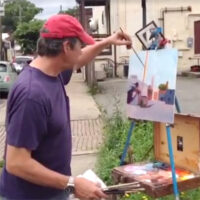 25,000 > 90 > 12 > 1. Those are my numbers. God seems to work in terms of reduction, doesn’t he? He did so with Gideon, with sending Jesus to fulfill the role as Savior (the odds of 350+ prophesies fulfilled in one person? Crazy! Read here for a cool explanation). He did it with me in regards to my training, and with my life. My vision field is less than 10% of normal, yet I see clearer than ever, and I see as an artist better than ever.
25,000 > 90 > 12 > 1. Those are my numbers. God seems to work in terms of reduction, doesn’t he? He did so with Gideon, with sending Jesus to fulfill the role as Savior (the odds of 350+ prophesies fulfilled in one person? Crazy! Read here for a cool explanation). He did it with me in regards to my training, and with my life. My vision field is less than 10% of normal, yet I see clearer than ever, and I see as an artist better than ever.
I have learned, as have many others, that life isn’t about 29:11. If you think it’s about having a warm, cozy, successful life, watch out. Don’t get cynical, hopeless, careless, fearful. Look at history, human nature, the heart. There is something much grander than me and my moment. It’s not about getting, but responding.
29:10 tells us that there is a different timetable than the one we measure by. God’s is very long term, as in eternal long term. This life isn’t about getting it all. It seems more about being a part of something that encompasses all of us, the beauty coming when we trust, love, and live opportunistically by faith in what lies ahead, even if we cannot see it. A beautiful tapestry.
Seeing Past the Bliss
I realize that my story began with art and took a spiritual turn after my diagnosis. I guess that’s to be expected. Painting is a hugely personal and emotional endeavor. I read that Monet’s productivity would cease when troubles became more than he could handle. Great creativity is very much intuitive and thus requires a clear, free mind and spirit to do its thing. I couldn’t have painted another brushstroke if I didn’t have the peace that I was on solid ground, i.e. in good hands.
Along the same line, great creative works have a depth to them. Amazing execution is nothing more than show without meaning and heart driving it.
No longer is my goal to create a skilled piece. No longer do I just art by its display of skill. Now I look for heart. My motivation is to be fearless and free, yet aware and compassionate. I think many of us live in selective bliss as we glide through our busy days. I did.
So, I am painting what I see- both the incredible beauty of nature and the incredible inhumanity of man. There is an inherent dignity in both- but I think we close our eyes to the pain as if it that will make it go away. Take it from me- the bad will not go away. Like fears, injustice will only grow if we don’t face it.
My hope is that people will appreciate the beauty, but more importantly, see the power they have within to make a positive difference in their world. The moment- this moment, right here, right now, matters. What will we do with it? Let it slip by? That would be a shame. I want to do something.
And for me, that means being aware and responsive. To the need. To the beauty. I believe that art can be very powerful way to speak the truth with humility.
No matter what ails me, I do, because today, I can.
P.s. I am painting up a storm! I invite you to browse my portfolio and available paintings.

